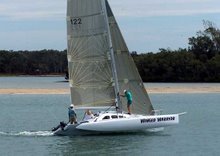 It's been awhile, but I am back in blogging business. So what happened?? First I got the joined hulls away from the floor so I could remove the strong back, after care full making the position on the floor for reuse for the main hull. Then I sanded the floor to give it two coats of 2part varnish I was generously given by Jorn Bagger (see ealier blog: the guy in the grey work suit, a great friend of mine). This makes cleaning much easier, since glass fibre stick to anything, so a smooth floor makes it easy to sweep.
It's been awhile, but I am back in blogging business. So what happened?? First I got the joined hulls away from the floor so I could remove the strong back, after care full making the position on the floor for reuse for the main hull. Then I sanded the floor to give it two coats of 2part varnish I was generously given by Jorn Bagger (see ealier blog: the guy in the grey work suit, a great friend of mine). This makes cleaning much easier, since glass fibre stick to anything, so a smooth floor makes it easy to sweep. I then started taping the half floats together:
I then started taping the half floats together:First a fillet of glass bubbles and epoxy is spread with a bakers bag, and smooth of with a stick.
 A glass tape is saturated with epoxy using a plastic sqeegee. I use this plate with a vacuum tape edge, and a plastic sheet. Then I can easily change the plastic, the next day. The plate can be moved around as well.
A glass tape is saturated with epoxy using a plastic sqeegee. I use this plate with a vacuum tape edge, and a plastic sheet. Then I can easily change the plastic, the next day. The plate can be moved around as well. This is a bit tricky to reach all areas, so a stick to place the tape is handy, as well as a long brush. Peel ply is used to help create a smooth surface, this I found out during the fitting of bulkheads. I cut a 10 cm roll out of the big one I got so it is easy to apply a strip to the glass tape.
This is a bit tricky to reach all areas, so a stick to place the tape is handy, as well as a long brush. Peel ply is used to help create a smooth surface, this I found out during the fitting of bulkheads. I cut a 10 cm roll out of the big one I got so it is easy to apply a strip to the glass tape. The gusset between stringers ready to glass in place. Gusset is foam, glasssheated.
The gusset between stringers ready to glass in place. Gusset is foam, glasssheated. The finished chainplate with carbon and glass on top
The finished chainplate with carbon and glass on top
I fitted a high density foam in after i fitted the chainplate to see what i was doing inside. The big mistake here is that I should have fitted the chainplate before i joined the hulls, much easyer and better.
 Chainplate testfitting.
Chainplate testfitting. A selection of the tools I used so far, including nailboard in middle to perforate bulkheads before vacuumbagging. Japanese saw is great for trimming foam with only one side glassed, since it cuts when pulled so glass is not forced away from foam but against. This is not all the tools I used but most.
A selection of the tools I used so far, including nailboard in middle to perforate bulkheads before vacuumbagging. Japanese saw is great for trimming foam with only one side glassed, since it cuts when pulled so glass is not forced away from foam but against. This is not all the tools I used but most.













2 comments:
Hi Martin,
actuel i startet forming the first foam parts and i purchase the materials to laminate the floats. The thimbles i got from precout. Which material do you use inside for joining the float halves, instead of the Knytex? Do you think i can use B.D. -45/+45 400g/m²? Do you use for the carbon chain plate U.D. Carbon 450g/m² like on plans? What do you use o top of the chain plate?
Thank you for your efforts
Greetings
Robert
I got the tape you see on the photo, it is 225 g/m2 so I use two tapes per seam. It would be easier if you could get some heavier tape like Knytex or similar, like the one you mention 45/45 400g/m2 but i am not sure if one layer is enough. I would ask Ian Farrier.
I use 300 g/m2 uni carbon, and I simply calculate hom many grams the item needs and divide this by 300. ¨
Ex. an item needs 5 layers of 450 g/m2 uni : 5x450 = 2250g. 2250g/300g= 7,5 layer that equals 8 layers to be sure.
Over chain plates is a layers of glass 400 g and another layer when fitted in the float.
And try to install chainplates before joining hulls, i did not and it was a bit tight and messy.
Happy building
Post a Comment